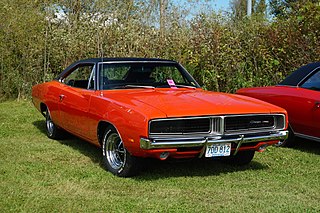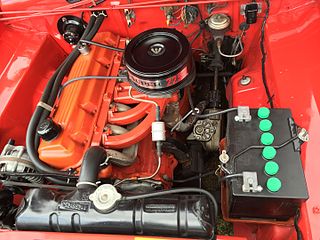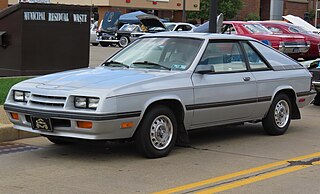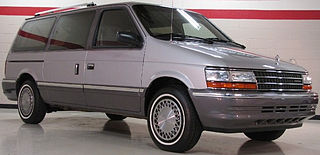Dodge is an American brand of automobiles and a division of Stellantis North America, based in Auburn Hills, Michigan. Dodge vehicles have historically included performance cars, and for much of its existence Dodge was Chrysler's mid-priced brand above Plymouth.

Plymouth was a brand of automobiles produced by Chrysler Corporation and its successor DaimlerChrysler. The brand was launched in 1928 to compete in what was then described as the "low-priced" market segment that was dominated by Chevrolet and Ford. It became a high-volume seller for the automaker until the late 1990s. Plymouth cars were marketed primarily in the United States. The brand was withdrawn from the marketplace in 2001. The Plymouth models that were produced up to then were either discontinued or rebranded as Chrysler or Dodge.

The Plymouth Reliant and Dodge Aries are mid size cars introduced for model year 1981 as the first "K-cars" manufactured and marketed by the Chrysler Corporation. The Reliant and Aries were the smallest cars to have the traditional 6 passenger 2 bench seat with column shifter seating arrangement favored by customers in the United States, similar to larger rear-wheel drive cars such as the Dodge Dart and other front-wheel drive cars such as the Chevrolet Celebrity. The Reliant was powered by a then-new 2.2 L I4 SOHC engine, with a Mitsubishi "Silent Shaft" 2.6 L as an option. The Reliant was available as a 2-door coupe, 4-door sedan, or as a 4-door station wagon, in three different trim lines: base, Custom and SE. Station wagons came only in Custom or SE trim.

The Dodge Daytona is an automobile which was produced by the Chrysler Corporation under their Dodge division from 1984 until 1993. It was a front-wheel drive hatchback based on the Chrysler G platform, which was derived from the Chrysler K platform. The Chrysler Laser was an upscale rebadged version of the Daytona. The Daytona was restyled for 1987, and again for 1992. It replaced the Mitsubishi Galant-based Challenger, and slotted between the Charger and the Conquest. The Daytona was replaced by the 1995 Dodge Avenger, which was built by Mitsubishi Motors. The Daytona derives its name mainly from the Dodge Charger Daytona, which itself was named after the Daytona 500 race in Daytona Beach, Florida.

The Dodge Charger is a model of automobile marketed by Dodge in various forms over eight generations since 1966.

The Plymouth Valiant is an automobile which was marketed by the Plymouth division of the Chrysler Corporation in the United States from the model years of 1960 through 1976. It was created to give the company an entry in the compact car market emerging in the late 1950s. The Valiant was also built and marketed, without the Plymouth brand, worldwide in countries including Argentina, Australia, Brazil, Canada, Finland, Mexico, New Zealand, South Africa, Sweden and Switzerland, as well as other countries in South America and Western Europe. It became well known for its excellent durability and reliability, and was one of Chrysler's best-selling automobiles during the 1960s and 1970s, helping to keep the company solvent during an economic downturn.

The K-car platform was a key automotive design platform introduced by Chrysler Corporation for the 1981 model year, featuring a transverse engine, front-wheel drive, independent front and semi-independent rear suspension configuration—a stark departure from the company's previous reliance on solid axle, rear-drive unibody configurations during the 1970s. Derived from Chrysler's L-cars, the Plymouth Horizon and Dodge Omni, the platform was developed just as the company faltered in the market, at first underpinning a modest range of compact/mid-size sedans and wagons—and eventually underpinning nearly fifty different models, including all-wheel drive variants—and playing a vital role in the company's subsequent resurgence.

The Dodge Omni and the nearly identical badge engineered variant, the Plymouth Horizon, is a subcompact car manufactured and marketed by Chrysler Corporation for model years 1978-1990. The first Chrysler model line produced with front-wheel drive, the Omni and Horizon were also the first front-wheel drive economy cars assembled in the United States. Marketed for eleven years with very few changes, around 2,500,000 Omnis and Horizons were manufactured, with the Plymouth variants more popular than the Dodge-branded models.

The Slant-Six is the popular name for a Chrysler inline-6 internal combustion engine with an overhead valve reverse-flow cylinder head and cylinder bank inclined at a 30-degree angle from vertical. Introduced in 1959 for the 1960 models, it was known within Chrysler as the G-engine. It was a clean-sheet design that began production in 1959 at 170 cubic inches (2.8 L) and ended in 2000 at 225 cubic inches (3.7 L). It was a direct replacement for the flathead Chrysler straight six that the company started business with in 1925 until the old design was discontinued in the 1960s.

The 2.2 and 2.5 are a family of inline-4 engines developed by Chrysler Corporation originally for the Chrysler K- and L-platforms cars and subsequently used in many other Chrysler vehicles. After its launch in 1981, it became the basis for all Chrysler-developed 4-cylinder engines until the Chrysler 1.8, 2.0 & 2.4 engine family was released in 1994. It was the first Chrysler engineered four cylinder engine since the Chrysler flathead four cylinder was discontinued in 1933.

The Dodge Colt is a subcompact car that was manufactured by Mitsubishi Motors and marketed by Dodge for model years 1971 to 1994 as captive imports. Rebadged variants include the Plymouth Champ and Plymouth Colt, both were marketed by Plymouth.

The Dodge Magnum is a nameplate used by several Dodge vehicles, at different times and on various markets. The name was first applied to a large Chrysler B platform-based 2-door coupe marketed from 1978 to 1979 sold in the United States and Canada. From the 2005 to the 2008 model years, the nameplate was revived for a Charger-based station wagon on the rear-wheel drive Chrysler LX platform, produced in Canada and sold on the American and Canadian market.

The Jeep Comanche is a pickup truck variant of the Cherokee compact SUV (1984–1992) manufactured and marketed by Jeep for model years 1986-1992 in rear wheel (RWD) and four-wheel drive (4WD) models as well as two cargo bed lengths: six-foot and seven-foot.

The Plymouth Fury is a model of automobile that was produced by Plymouth from 1955 until 1989. It was introduced for the 1956 model year as a sub-series of the Plymouth Belvedere, becoming a separate series one level above the contemporary Belvedere for 1959. The Fury was a full-size car from 1959 until 1961, then a mid-size car from 1962 until 1964, again, a full-size car from 1965 through 1974, and again, a mid-size car from 1975 through 1978. From 1975 until 1977, the Fury was sold alongside the full-size Plymouth Gran Fury. In 1978, the B-body Fury was the largest Plymouth, and by 1979, there was no large Plymouth. This product gap was filled in 1980 with the R-body Gran Fury, followed by the M-body Fury in 1982. Production of the last V8, RWD Plymouth Fury ended at the Kenosha Main assembly plant in Kenosha, WI, on December 23, 1988. Unlike its sibling brand, Dodge, Plymouth would not live to see the resurgence of the large, V8/RWD sedan.

TorqueFlite is the trademarked name of Chrysler Corporation's automatic transmissions, starting with the three-speed unit introduced late in the 1956 model year as a successor to Chrysler's two-speed PowerFlite. In the 1990s, the TorqueFlite name was dropped in favor of alphanumeric designations, although the latest Chrysler eight-speed automatic transmission has revived the name.
Chrysler's L platform was used in a family of compact automobiles produced from 1978 to 1990. Loosely based on the Simca 1100 platform developed with Chrysler backing in Europe in the 1960s, the Chrysler L-body was the first domestically made car with transverse front wheel drive using a unibody chassis. It was created in response to the energy crisis of the 1970s and the desire to save internal costs by consolidating Chrysler's American and European operations. It was sold in North America in several lines of similar Dodge and Plymouth vehicles and discontinued when the Chrysler K platform was more successful.

The Dodge Omni 024 was a modified version of the popular Dodge Omni made from 1979 to 1982. Analogous to the VW Scirocco, this car was a lower, sportier three-door hatchback coupé version of the Chrysler/Simca Horizon, using the five-door hatchback's floor pan and chassis as a basis. The cars were designed in-house at the prompting of Lee Iacocca.

The Dodge Charger (L-body) is a subcompact two-door hatchback/fastback built by Dodge from 1981 until 1987. It is based on Chrysler's front-wheel drive L platform. A companion model, the Plymouth Turismo, was also marketed.

The first-generation Chrysler minivans are a series of minivans produced and marketed by the Chrysler Corporation from the 1984 to the 1990 model years. Introduced as the first minivans from an American-brand manufacturer and popularizing the minivan as a vehicle, the Dodge Caravan and Plymouth Voyager were launched ahead of chief competitors Chevrolet Astro/GMC Safari and Ford Aerostar.

The second-generation Chrysler minivans are a series of minivans that were manufactured and marketed by Chrysler Corporation in North America and Europe from 1991 to 1995. Officially designated the AS platform by Chrysler, the second-generation minivans were an extensive revision of the first-generation chassis and body. As before, passenger and cargo configurations were sold by Dodge, Plymouth, and Chrysler divisions. The first minivans offered with driver-side airbags and with optional integrated child safety seats, the second-generation Chrysler minivans offered all-wheel drive as an option for the first time; a manual transmission would be offered for the last time in the North American market.






















